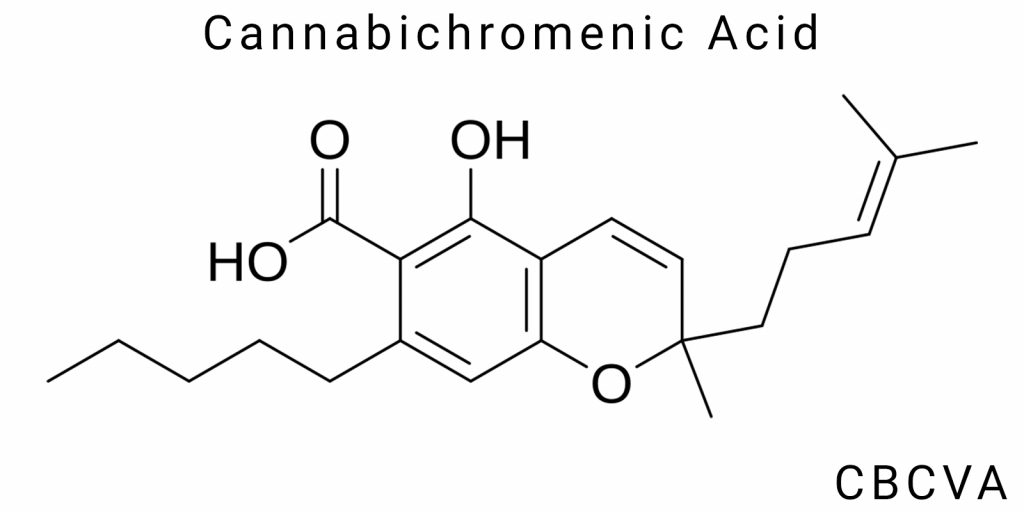Cannabichromenic acid (CBCVA) is one of the lesser-known compounds among the cannabinoids found in cannabis plants. Like other cannabinoids, CBCVA has garnered significant scientific interest due to its potential pharmacological properties and its role in the metabolic pathways that synthesize other cannabinoids. However, unlike well-studied cannabinoids such as Δ9-tetrahydrocannabinol (THC) or cannabidiol (CBD), CBCVA remains a poorly understood compound that requires more detailed investigation.
This cannabinoid serves as a precursor to cannabichromene (CBC) and its derivatives, such as cannabichromenic acid (CBCA). However, it is present in much smaller quantities in cannabis plants, which complicates its study and practical applications. Of particular importance is CBCVA’s role in cannabinoid biosynthesis and its potential for medical use, thanks to its possible antioxidant, anti-inflammatory, and neuroprotective properties.
Research on CBCVA includes both plant-based experiments and modeling the compound’s effects on human biological systems. Although its therapeutic potential remains limited due to a lack of empirical studies, preliminary findings suggest that CBCVA may be effective in treating various diseases, particularly neuropathic disorders and inflammatory conditions.
This paper explores the chemical structure, biosynthesis, and methods of synthesizing cannabichromenic acid, as well as its pharmacological effects. Special attention is given to analyzing the existing research and the potential use of CBCVA in medical and pharmaceutical practices.
Introduction: What is Cannabichromenic Acid (CBCVA)?
Cannabichromenic acid (CBCVA) is one of the many naturally occurring compounds belonging to the cannabinoid class found in Cannabis plants. Cannabinoids, particularly those present in hemp, have long attracted scientific attention due to their unique ability to interact with cannabinoid receptors in the human body, opening new possibilities for their use in medicine. Although CBCVA is present in relatively small quantities in Cannabis plants, it is an important precursor to key cannabinoids such as cannabichromene (CBC) and cannabichromenic acid (CBCA). Like other cannabinoids, CBCVA exhibits potential therapeutic properties, though further research is required to fully explore its potential.
Unlike more extensively studied cannabinoids like cannabidiol (CBD) and tetrahydrocannabinol (THC), CBCVA is still at a relatively early stage of scientific investigation. However, its molecular structure, biosynthesis, and pharmacological properties have already sparked interest across various scientific fields. This compound holds the potential to expand our understanding of cannabinoid systems and reveal new opportunities for medical applications.
A Brief History of CBCVA Research
Cannabinoid research began in the mid-20th century when scientists first identified the primary compounds in Cannabis sativa. However, it was only in recent decades, with the advancement of chemical and biological techniques, that researchers have been able to delve deeper into newly discovered cannabinoids such as cannabichromene (CBC), cannabidiol (CBD), and cannabichromenic acid (CBCVA). Because CBCVA is present in very small amounts in cannabis, it has not been studied as rapidly as other cannabinoids. Nevertheless, a number of studies focusing on cannabinoid metabolism have highlighted the importance of CBCVA as a precursor for the synthesis of other cannabinoids, making it crucial for studying the biosynthesis of cannabinoids in Cannabis plants.
Early research on CBCVA primarily focused on its chemical structure and synthesis mechanisms in cannabis plants. However, most scientific studies have been directed at exploring other, more abundant cannabinoids. It wasn’t until the past decade that interest in CBCVA began to grow, particularly with the expansion of research into the human endocannabinoid system and its potential therapeutic uses.
Key Reasons Why This Cannabinoid Attracts Scientific Interest
CBCVA draws attention for several key reasons:
- Biosynthesis and Cannabinoid Synthesis: One of the main reasons for interest in CBCVA is its role as a precursor to other important cannabinoids like CBC and CBCA. This offers an opportunity to study the cannabinoid synthesis pathway in plants and gain a deeper understanding of how cannabis plants produce these compounds. Researching these metabolic pathways could lead to improved selection methods and genetic engineering techniques to increase the concentration of beneficial cannabinoids in plants.
- Potential Pharmacological Properties: While research on CBCVA is still in its early stages, preliminary results suggest it may have therapeutic potential. Other cannabinoids, such as CBC, are known for their analgesic, anti-inflammatory, and neuroprotective properties. CBCVA may exhibit similar effects, as many cannabinoids produce similar outcomes by interacting with cannabinoid receptors in the body.
- Low Concentration in Natural Sources: Another reason to study CBCVA is its rarity in cannabis plants. Because it occurs in significantly smaller amounts compared to other cannabinoids, researchers are exploring ways to synthesize and isolate it in laboratory conditions, which would allow for better understanding of its properties and potential applications.
- Environmental and Economic Potential: The use of cannabinoids in medical and pharmaceutical practices contributes to the growing interest in cannabis as a raw material. Since CBCVA can be an important precursor for other compounds, understanding its properties helps develop new methods for processing and utilizing plant material. This could also promote the development of eco-friendly cannabinoid synthesis techniques.
Biosynthesis of CBCVA: How it Forms in Nature
The process of synthesizing cannabichromenic acid (CBCVA) is part of a complex biochemical system occurring in cannabis plants (Cannabis sativa). Like other cannabinoids, CBCVA is formed through a series of enzymatic reactions that convert precursor molecules into the final product. The primary biosynthetic pathway of CBCVA is part of the broader cannabinoid metabolism process in plants, involving specific enzymes responsible for converting acidic forms of cannabinoids into their non-acidic counterparts.
Synthesis Processes of CBCVA in Cannabis Plants
- Synthesis of Cannabichromenic Acid (CBCA): The synthesis of CBCVA begins with the formation of cannabichromenic acid (CBCA), a precursor for several cannabinoids, including CBC, CBD, and CBCVA. This process is catalyzed by the enzyme cannabichromenic acid synthase (CBCA-S).
- Conversion of CBCA into CBCVA: CBCVA forms through the action of a specific enzyme, cannabichromenic acid synthase (CBCVA-S), which catalyzes the conversion of CBCA into CBCVA through chemical reactions that involve adding or substituting a carbon molecule in the structure.
- Enzymatic Steps: Typically, the conversion of cannabinoid acids (like CBCA) into their non-acidic variants involves decarboxylation, a process typically catalyzed by specific enzymes under the influence of heat or other chemical processes. However, CBCVA doesn’t always undergo the standard decarboxylation process, making its synthesis more specific compared to other cannabinoids.
Interaction with Other Phytocannabinoids, Including CBC and CBD
Cannabichromenic acid (CBCVA) is a direct precursor to cannabichromene (CBC), one of the major cannabinoids in Cannabis plants. CBC itself has numerous pharmacological properties, including analgesic, anti-inflammatory, and neuroprotective effects. The conversion of CBCVA into CBC through specific enzymes is a crucial step in biosynthesis, as it increases the number of cannabinoids capable of influencing the body through cannabinoid receptors.
As for cannabidiol (CBD), while this cannabinoid belongs to a different class of cannabinoids than CBC, its synthesis and biosynthesis could also affect the formation of other cannabinoids, including CBCVA. However, the metabolic processes of CBCVA and CBD may be partially independent, depending on the plant species and specific growth conditions. The interaction between these cannabinoids, while not as straightforward, can still have some impact on the therapeutic potential of each, as cannabinoids can influence the body through shared biological mechanisms.
Factors Affecting the Formation of CBCVA in Plants
The synthesis of CBCVA, like other cannabinoids, depends on several ecological, genetic, and biochemical factors. Key factors influencing the production of CBCVA in cannabis plants include:
- Plant Genetics: The genetic makeup of cannabis plants plays a significant role in cannabinoid production. There are different gene variants responsible for synthesizing cannabinoid acids and their conversion into cannabinoids. For instance, genetic mutations or selective breeding programs can increase or decrease the levels of enzymes responsible for forming CBCVA, as well as its subsequent conversion into CBC or other cannabinoids.
- Growing Conditions: Environmental factors such as light, temperature, humidity, and soil type can impact the activity of the enzymes involved in cannabinoid synthesis. For example, high temperatures or stressful conditions for the plant can increase cannabinoid production, including CBCVA, as the plant responds to stress by producing these compounds.
- Plant Developmental Stage: The levels of cannabinoids, including CBCVA, change throughout the plant’s life cycle. The highest concentrations are typically found during the late flowering stages when the plant is actively producing resin that contains cannabinoids. At earlier stages, the levels of CBCVA may be lower as the enzymes responsible for its production are not yet fully active.
- Cultivation and Processing Technologies: Innovations in agriculture, such as controlled environments for growing cannabis (e.g., hydroponics or specific lighting schedules), can also enhance cannabinoid content, including CBCVA. Specialized fermentation or extraction methods can increase the concentration of cannabinoids, even those present in small amounts in the plants.
Molecular Structure and Chemical Properties
Analysis of CBCVA’s Chemical Structure
Cannabichromene acid (CBCVA) is a unique cannabinoid that belongs to the class of phytocannabinoids found in Cannabis sativa plants. The molecular structure of CBCVA incorporates several key components that define its chemical and physiological properties. It consists of three main parts:
- Aromatic Ring: This is the foundational structure of cannabinoids, consisting of a benzene ring with double bonds between the carbon atoms. The aromatic component is characteristic of most cannabinoids, allowing them to interact with receptors in the human body, particularly CB1 and CB2 cannabinoid receptors.
- Alkyl Chain: An alkyl chain made up of five carbon atoms extends from the benzene ring in the CBCVA molecule. This chain plays a significant role in the molecule’s ability to penetrate cell membranes and affect biological processes. Like other cannabinoids, this chain can influence the solubility and stability of the molecule in the body.
- Carboxyl Group: One defining feature of CBCVA is the presence of a carboxyl group (–COOH), which imparts an acidic nature to the molecule. This is an important factor, as carboxyl groups tend to participate in acid-base reactions, contributing to specific chemical properties of CBCVA. One such property is its ability to undergo decarboxylation (loss of a CO2 molecule) when heated or under certain conditions, which converts CBCVA into its non-acidic form, cannabichromene (CBCV).
This structure gives CBCVA characteristics that distinguish it from other cannabinoids, such as cannabichromene (CBC) and cannabidiol (CBD), enabling it to engage in complex biological interactions.
Comparison of CBCVA with Other Cannabinoids
Molecular differences between CBCVA and other cannabinoids, such as CBC and CBD, significantly influence their biological activity and interaction with receptors in the body.
- CBCVA vs. CBC: CBC and CBCVA share many similarities in their structure, including the common aromatic part and a similar alkyl chain. However, the presence of the carboxyl group in CBCVA provides an additional acidic property that CBC lacks. This allows CBCVA to exhibit unique features in its mechanism of action. Due to its acidic nature, CBCVA is more stable in the early stages of biological processes. Under the influence of heat or enzymatic reactions, CBCVA can convert into CBC, which loses its acidity and displays more pronounced activity.
- CBCVA vs. CBD: In contrast to cannabidiol (CBD), the CBCVA molecule has a significant difference with the presence of a carboxyl group, giving it acidic properties. CBD, on the other hand, has a more neutral chemical composition, affecting its ability to interact with cannabinoid receptors, especially serotonin receptors (5-HT1A). This gives CBD specific psychoactive effects, including anxiolytic (anti-anxiety) activity, which can be useful in treating anxiety disorders. In contrast, CBCVA primarily acts through CB1 and CB2 cannabinoid receptors, thanks to its carboxyl group, which imparts acidic properties.
- Mechanism of Action and Biological Activity: The chemical structure of CBCVA allows it to impact various molecular pathways. This enables its potential use for medical purposes, particularly for influencing pain, inflammation, and other pathological conditions. Like other cannabinoids, CBCVA can bind to CB1 and CB2 receptors, leading to therapeutic effects. However, it is specifically the carboxyl group and its ability to undergo decarboxylation that make it an interesting candidate for the development of new applications, including enhancing the stability of cannabinoids for storage and delivery in the body.
Key Chemical Properties that Define Cannabinoid Activity
The chemical properties of CBCVA play a pivotal role in its biological activity, affecting absorption processes, transport, and interaction with receptors in the body. Let’s consider several key aspects of the chemical properties of this cannabinoid:
- Acid-Base Properties: The carboxyl group in the CBCVA molecule imparts acidic properties, which can be crucial for biochemical transformation processes. Due to its acidic nature, CBCVA is more stable in acidic environments, allowing it to remain in the plant until it is converted into its non-acidic form under heat or fermentation. Decarboxylation is essential for the effective application of cannabinoids, as the active form, CBCV, can have different pharmacological effects.
- Molecular Stability and Temperature Properties: CBCVA differs from other cannabinoids due to its stability at lower temperatures, thanks to the carboxyl group. However, during heating (for example, when preparing cannabis products), it can quickly transition to a non-acidic form, making it effective in certain therapeutic applications. Understanding the stability of the molecule is crucial for the practical use of cannabinoids in medical contexts.
- Solubility and Interaction with the Body: Due to the presence of polar groups, the CBCVA molecule has some ability to dissolve in aqueous environments, although its primary interactions occur through organic solvents. This is important for understanding how the cannabinoid can be effectively delivered into the body. Studying the solubility and the mechanisms of the molecule’s penetration into cells allows for the identification of optimal methods for its therapeutic use.
Methods of CBCVA Production
Technologies for Obtaining CBCVA from Cannabis Plants
The production of cannabichromene acid (CBCVA) primarily relies on the biogenesis that occurs in Cannabis sativa plants through natural metabolic processes. As CBCVA is a precursor to other cannabinoids, its production depends on a variety of factors, including growing conditions and the influence of various chemical agents.
- Extraction from Plant Material: One of the main methods for obtaining CBCVA is by extracting it from dried hemp plants. Various solvents, such as ethanol, hexane, or CO2 under critical conditions, are used to extract the active components from the plant. CO2 extraction, in particular, has an advantage as it is safe, environmentally friendly, and preserves a high concentration of phytocannabinoids, including CBCVA. After extraction from the raw material, a cannabinoid extract is obtained, which contains both acidic and non-acidic forms of cannabinoids.
- Mechanism of CBCVA Formation in the Plant: In natural conditions, cannabichromene acid is formed in hemp plants through enzymatic processes. In specialized plant cells, cannabinoids are biosynthesized via intermediate compounds, such as cannabigerolic acid (CBGA). In this context, CBCVA is the product of a metabolic pathway that occurs under the influence of enzymes like cannabichromenic acid synthase, which catalyzes the conversion of CBGA into cannabichromenic acid (CBCA), and further into CBCVA.
- Factors Influencing CBCVA Formation: Environmental factors such as temperature, humidity, light, and soil type significantly impact the level of cannabinoid synthesis in hemp plants. Different genetic strains of Cannabis sativa can have varying potential for synthesizing CBCVA, influencing its concentration in the plant material. Farmers and cannabis producers can optimize growing conditions to maximize cannabinoid content, including CBCVA.
Laboratory Methods for CBCVA Synthesis and Purification
In laboratory settings, methods for synthesizing CBCVA directly, bypassing the plant-growing stage, exist. These methods are particularly important for scientific research and small-scale production.
- Chemical Synthesis of CBCVA: One of the primary laboratory methods for synthesizing CBCVA involves the chemical modification of other cannabinoids, such as cannabichromenic acid (CBCA). In this case, CBCA can be modified into CBCVA through the attachment of additional functional groups or under specific reaction conditions. This process is complex and requires careful control of conditions such as temperature, pH, reagent concentration, and reaction time. Laboratory synthesis of CBCVA allows for its production in pure form, which is essential for further research.
- Cannabinoid Isomerization: In some cases, isomerization techniques are used to obtain CBCVA, in which cannabinoids with different molecular structures are converted into the desired cannabinoid. Through isomerization, molecular structures are altered under controlled conditions, leading to the formation of CBCVA from other compounds such as cannabichromene or cannabidiol.
- Chromatography for Purification: After cannabinoid synthesis or extraction from plant material, the next step is purification of the obtained samples. Chromatographic methods such as column chromatography or thin-layer chromatography (TLC) are widely used to separate different cannabinoids based on their physicochemical properties. Purification of cannabinoids is an essential part of the process as it ensures the production of highly purified compounds required for scientific research or therapeutic applications.
- Cryogenic Purification Methods: An innovative purification method involves the use of cryogenic chromatography. In this method, cannabinoid-containing extracts are frozen and treated at low temperatures, allowing for the removal of unwanted molecules and resulting in a purer form of CBCVA. This method can be useful when other purification techniques are insufficiently effective.
Prospects for Biotechnological Production Methods
In recent years, biotechnological methods have become increasingly popular for synthesizing phytocannabinoids, including CBCVA. These methods utilize living organisms or their components to produce cannabinoids, significantly simplifying processes and reducing costs.
- Genetically Modified Microorganisms: One of the main biotechnological approaches involves using genetically modified microorganisms, such as yeast or bacteria, to synthesize cannabinoids. These microorganisms can be engineered to produce specific cannabinoids, including CBCVA, through enzymatic processes. The use of such biological systems allows for the simplification of cannabinoid production without the need for large-scale hemp cultivation.
- Fermentation: The fermentation method is also actively used in cannabinoid production through biotechnology. In this case, genetically modified organisms such as Saccharomyces cerevisiae yeast ferment organic substrates, converting them into cannabinoids. This method enables the large-scale production of cannabinoids using relatively simple starting materials. Fermentation is a promising route for biotechnological production of CBCVA, as it is more efficient and less costly compared to traditional methods such as plant cultivation.
- Synthesis through Plant Tissues: Another biotechnological approach involves using hemp cell cultures for cannabinoid production. The technology of cell culture induction allows for the growth of plant cells in laboratory conditions where they can synthesize cannabinoids. This significantly reduces the need for large amounts of raw material and facilitates better control over the synthesis conditions, leading to cleaner and more efficient production of CBCVA.
Biotechnological methods for cannabinoid production are of great importance for expanding the applications of cannabinoids in the pharmaceutical and food industries. These technologies enable large-scale production without the need for vast areas of hemp cultivation. The development of these methods also allows for the creation of new cannabinoid-based products, including CBCVA, with reduced costs and greater purity.
Pharmacological and Therapeutic Properties of CBCVA
Research on Biological Activity and Potential Therapeutic Effects
Cannabichromene acid (CBCVA) has attracted attention from scientists due to its potential biological and therapeutic properties. Like other cannabinoids, CBCVA exhibits certain biological activity, making it a subject of research for medical applications. However, compared to more well-known cannabinoids, such as THC (tetrahydrocannabinol) or CBD (cannabidiol), CBCVA remains less studied, and scientific data on its mechanisms of action are limited.
Preliminary studies suggest that CBCVA has antioxidant activity, allowing it to reduce oxidative stress, which is a primary cause of many diseases, including cardiovascular and neurodegenerative disorders. Some data also indicate that CBCVA may have anti-inflammatory properties, making it a promising candidate for treating conditions associated with chronic inflammation.
Other preliminary studies point to a potential role for CBCVA in pain relief, particularly through its ability to interact with various receptors in the endocannabinoid system, which is crucial for managing pain and inflammation. This may be especially useful for people suffering from chronic pain or inflammatory diseases such as arthritis.
Potential Medical Applications of CBCVA
- Pain Treatment: One of the main therapeutic directions for CBCVA is its potential as an analgesic agent. A number of cannabinoid studies, including CBC and CBD, have shown their ability to interact with cannabinoid system receptors in the body, affecting the perception of pain. Since CBCVA is structurally similar to CBC, it is reasonable to assume that it may also exhibit analgesic properties. Animal studies have shown that cannabinoids can reduce pain sensitivity by activating CB2 receptors, which potentially makes CBCVA useful in the treatment of pain related to chronic inflammation or neurological disorders.
- Anti-Inflammatory Effects: CBCVA also holds potential in combating inflammation. Research on cannabinoids has shown that they can lower inflammatory markers and reduce inflammation, making them useful in treating conditions such as chronic pain, arthritis, and even certain autoimmune disorders. While data specifically on CBCVA is limited, it is believed that this cannabinoid may act through mechanisms similar to those of other cannabinoids, which are capable of modulating immune cell activity and inflammatory processes.
- Psychiatric Disorders: Another potential area of application for CBCVA is psychiatry. Like other cannabinoids, CBCVA may have properties that aid in the treatment of psychiatric disorders such as depression, anxiety disorders, and post-traumatic stress disorder (PTSD). Cannabinoids can influence neuroplasticity and neurotransmitter balance in the brain, which may have therapeutic effects for such disorders. Given the research on cannabidiol (CBD) and cannabichromene, CBCVA may affect these mechanisms as well, though with some differences due to its chemical structure.
- Antioxidant Properties: Since oxidative stress is a key factor in many diseases, including neurodegenerative conditions (e.g., Alzheimer’s and Parkinson’s diseases), cannabinoids with antioxidant properties may be effective in their prevention and treatment. CBCVA shows some potential in this area by reducing free radical levels in cells, which may help protect neurons and other cells from damage caused by oxidative processes.
Comparing the Effectiveness of CBCVA with Other Cannabinoids
It is important to note that, despite its positive properties, research on CBCVA is still in its early stages, and comparisons of its effectiveness with other cannabinoids such as THC, CBD, or CBC may be limited due to the lack of sufficient clinical studies. However, some assumptions can be made based on the known properties of other cannabinoids:
- Cannabichromene (CBC) and cannabidiol (CBD) have already proven effective in reducing pain and inflammation, as well as having psychotherapeutic potential. Unlike these cannabinoids, CBCVA has an additional acid group in its structure, which could alter its physicochemical and pharmacological properties. This may make it more active or cause it to have different mechanisms of action that still require detailed investigation.
- Tetrahydrocannabinol (THC), the main psychoactive component of cannabis, has well-studied properties, including analgesic and anti-inflammatory effects. However, unlike THC, CBCVA does not exhibit psychoactive activity, making it safer for use in the treatment of chronic diseases where the avoidance of psychotropic effects is essential.
Research and Scientific Discoveries on CBCVA
Overview of Key Scientific Studies on CBCVA
Although cannabichromene acid (CBCVA) is a relatively new subject of research among cannabinoids, important publications focusing on its physicochemical properties, biological activity, and potential therapeutic applications have begun to emerge since the early 21st century. Since CBCVA is a compound that naturally occurs in cannabis plants, scientists are increasingly interested in its complex molecular characteristics and its interaction with other phytocannabinoids, such as cannabichromene (CBC) and cannabidiol (CBD).
One of the earliest significant studies on CBCVA focused on its synthesis and biogenesis in hemp plants. Researchers noted that the formation of CBCVA in cannabis is influenced by multiple factors, including the plant species, growing conditions, and the maturity of the plants. Studies on this cannabinoid at the molecular level have helped improve the understanding of how different cannabinoids interact with each other during synthesis.
Another important area of research is the pharmacological activity of CBCVA. Animal studies have shown that CBCVA possesses antioxidant activity and pain-relieving potential, particularly for chronic pain, which opens up new possibilities for its use in the treatment of inflammatory and painful diseases. However, it is worth noting that much more research has been conducted on cannabidiol (CBD) and cannabichromene (CBC), while CBCVA remains a relatively underexplored cannabinoid.
Conclusions from Recent Publications and Experiments
Recent publications focusing on CBCVA emphasize the study of its biological effects and the potential for using this cannabinoid in medicine. One of the main themes of research is the search for new methods of synthesizing and purifying CBCVA, which would allow for large-scale production of the cannabinoid for clinical trials.
Studies are also focused on examining its antioxidant properties, as oxidative stress is a key factor in the development of many serious diseases, including neurodegenerative diseases, cardiovascular disorders, and cancer. Experimental results have shown that CBCVA can effectively neutralize free radicals, thereby reducing the risk of developing chronic diseases. Its ability to interact with other cannabinoids is particularly interesting, as it opens up the possibility of creating combined therapeutic strategies.
Additionally, studies analyzing the effects of CBCVA on the human endocannabinoid system are noteworthy. Research shows that CBCVA may be useful for correcting dysfunctions in this system, especially in conditions such as chronic pain syndrome and depression. However, due to the lack of sufficient clinical trials, researchers have not yet drawn definitive conclusions about its effectiveness in these areas.
Prospects for Further Research and Study of CBCVA
There is currently a significant need for further research that will help fully uncover the potential of CBCVA. One of the most important areas is studying the effects of this cannabinoid on the endocannabinoid system in the context of various diseases. Investigating the molecular mechanisms of CBCVA’s action could lead to the development of new therapeutic strategies for treating chronic pain, psychiatric disorders, and neurodegenerative diseases.
Moreover, the study of biotechnological methods for producing CBCVA is crucial. Such methods would enable large-scale production of this cannabinoid for clinical studies and future use in medicine. This includes the development of new synthesis methods that can produce CBCVA in large quantities from cannabis plants or through biotechnological processes in laboratories.
At present, one of the most important tasks for scientists is to investigate the clinical efficacy of CBCVA, as there are still limited studies on humans that allow for a final assessment of the safety and effectiveness of this cannabinoid for treating specific diseases. Only after conducting clinical trials will it be possible to make conclusive statements regarding the potential use of CBCVA in medical practice.
Overall, the prospects for studying CBCVA appear promising, but more experimental and clinical research is necessary to fully explore its therapeutic potential.
Potential Applications and Future of CBCVA
Commercial and Medical Applications
Cannabichromene acid (CBCVA) holds significant potential for use across various fields of medicine and biotechnology, particularly in treating diseases related to the dysfunction of the human endocannabinoid system. Although research on CBCVA is still limited, there are grounds to believe that this cannabinoid could become an essential tool for treating a range of conditions, including chronic pain, inflammation, anxiety disorders, and for supporting neuroprotection in neurodegenerative diseases such as Alzheimer’s and Parkinson’s.
- Pain and Inflammation. One of the primary potential uses of CBCVA is its ability to reduce pain and inflammation, as demonstrated in several experimental studies. Researchers hypothesize that CBCVA may be effective not only in treating chronic pain but also in short-term post-surgical pain therapy, where traditional analgesics may be ineffective or cause side effects.
- Neuroprotection. Another significant feature of CBCVA is its antioxidant activity, which can help reduce oxidative stress in the body. This is particularly important in neurodegenerative diseases like Alzheimer’s and Parkinson’s. The potential for this cannabinoid to protect neurons from damage caused by free radicals is an area of active research.
- Anxiety and Mental Disorders. Other studies have shown that CBCVA may have calming properties, making it a promising candidate for treating mental disorders, particularly anxiety, depression, and post-traumatic stress disorder (PTSD). As a cannabinoid that interacts with receptors in the endocannabinoid system, it may help regulate stress levels and emotional well-being in patients.
- Therapeutic Potential in Cosmetics. Due to its potent antioxidant and anti-inflammatory properties, CBCVA may be a valuable ingredient in cosmetic products aimed at combating signs of aging, acne, and other inflammatory skin conditions.
- Commercial Applications. In the future, CBCVA could find applications in the development of new medical drugs, including painkillers, treatments for neurodegenerative diseases, and mental health disorders. Additionally, CBCVA may be used in the production of cosmetic products targeting younger audiences and as a food supplement due to its antioxidant properties.
Challenges and Issues Facing Science and Industry in the Use of CBCVA
Despite its significant potential, there are several serious challenges that could hinder the widespread application of CBCVA in medical practice and commercial production.
- Lack of Sufficient Scientific Data. One of the most significant issues is the limited number of clinical studies on the efficacy and safety of CBCVA. Most of the available publications are based on animal studies and laboratory models, so without additional human trials, it is difficult to draw definitive conclusions about its full therapeutic potential.
- Production and Purification Methods. Currently, producing CBCVA in significant quantities is a complex and costly process. Technologies that allow for efficient synthesis or extraction of this cannabinoid from plants need further refinement. This is especially true for biotechnological methods of producing CBCVA, which could become the foundation for large-scale production. However, these methods are still in the research phase and are not always economically viable.
- Stability and Purity Preservation. Another challenge is ensuring the stability and purity of CBCVA during production and storage. Since this cannabinoid is relatively unstable, its purification and storage require precise temperature and humidity control, which can be problematic for large-scale production.
Overview of the Legal Aspects of Cannabinoid Use
The legal status of cannabinoids is another important topic that requires consideration in the context of the potential uses of CBCVA. Different countries have varying legal frameworks regarding the legalization of cannabis and its components, which influence their medical use. In Ukraine, as in many other countries, cannabinoids, including those derived from cannabis, are subject to strict regulation, limiting their use in pharmaceuticals.
- Medical Cannabis Legalization. In countries where cannabis has already been legalized for medical purposes, such as Canada, certain U.S. states, and European countries, medical institutions are allowed to use cannabinoids to treat patients. However, in many countries, additional regulatory steps are required to obtain permission for the use of new cannabinoids, like CBCVA, in clinical practice.
- International Regulation. Under international agreements like the 1961 Single Convention on Narcotic Drugs, cannabis and its derivatives are controlled substances. However, in recent years, more countries have been revisiting their stance on cannabis and its components, which is allowing the growing cannabis market to expand.
- Prospects for Legal Regulation of CBCVA. For CBCVA to become available for medical use, it is important to establish clear legal norms and procedures for its testing, registration, and medical use. Much of this will depend on how quickly the scientific evidence confirming the efficacy and safety of this cannabinoid develops.
Conclusions
Cannabichromene acid (CBCVA) occupies an important position among cannabinoids, although its study is still in the early stages. Like other cannabinoids, CBCVA is produced in cannabis plants, but it stands out due to its unique molecular structure and potential therapeutic properties. A key feature of CBCVA is its ability to interact with the endocannabinoid system, opening new possibilities for treating a variety of diseases.
Despite the limited amount of research, CBCVA already demonstrates significant potential in areas such as pain relief, inflammation treatment, reducing oxidative stress, and neuroprotection. Its impact on mental health is particularly important, which could lead to the development of new therapeutic methods for treating mental disorders like depression and anxiety. However, for CBCVA to gain widespread recognition, further research is needed, especially clinical trials involving humans.
One crucial step is developing effective methods for synthesizing and extracting CBCVA from cannabis plants. Potential pathways include the use of biotechnological methods, such as recombinant DNA technology, which could significantly reduce production costs and make this cannabinoid more accessible for commercial use. However, the optimal conditions for obtaining CBCVA and purifying it to the necessary standards still need to be determined.
Additional research is now essential to assess its efficacy and safety. In-depth clinical trials will help confirm CBCVA’s potential in treating pain, inflammation, and mental disorders. Moreover, it will be necessary to establish optimal dosages and application methods for this cannabinoid in medical practice. Given the growing interest in phytocannabinoids and their role in medicine, CBCVA could become an important tool in the development of new pharmaceutical products.
In addition to its medical uses, CBCVA holds promise for application in the pharmaceutical and cosmetic industries. Its antioxidant and anti-inflammatory properties could be used to produce cosmetic products such as creams and serums that protect the skin from damage and promote rejuvenation. CBCVA also has potential for the production of dietary supplements, as it may have general health benefits for the body.
However, there are legal barriers to widespread use. Cannabinoids remain a subject of debate on the international level, and their legalization varies from country to country. Legal issues surrounding the production and use of cannabinoids are an important aspect that requires attention. Implementing unified international standards would help accelerate the legalization process and ensure CBCVA’s availability in the market.
Despite the numerous challenges faced by researchers and the industry, CBCVA has great prospects in the medical and pharmaceutical fields. Continued research, the development of new production technologies, and resolution of legal issues could make this cannabinoid an important tool in combating various diseases. Cannabichromene acid has real potential, and science is just beginning to unlock all its possibilities.
References:
- PubMed (National Library of Medicine) – a database of medical publications where one can find articles on the biological activity of cannabinoids.
URL: https://pubmed.ncbi.nlm.nih.gov/ - Google Scholar – a search engine for scientific publications that allows access to articles from various fields of science.
URL: https://scholar.google.com/ - ScienceDirect – a platform for accessing scientific journals and articles across multiple disciplines.
URL: https://www.sciencedirect.com/ - Nature – a journal that publishes high-quality scientific articles in biology, chemistry, and medicine.
URL: https://www.nature.com/ - Cannabis and Cannabinoid Research – a scientific journal dedicated to research on cannabinoids and their effects on health.
URL: https://home.liebertpub.com/publications/cannabis-and-cannabinoid-research/633 - National Institute on Drug Abuse (NIDA) – a U.S. national institute that publishes research and statistics on cannabinoids and their medical applications.
URL: https://www.drugabuse.gov/






